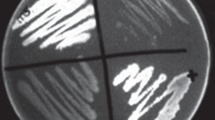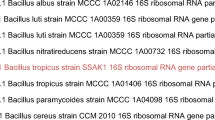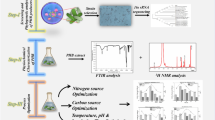Abstract
Polyhydroxybutyrate (PHB) is an eco-friendly, biodegradable plastic which exhibits properties very similar to the conventional plastic, thus, having high potential for replacing non-degradable conventional polypropylene plastic that is responsible for several environmental problems at global level. The present study focuses on the isolation and characterization of potential novel PHB producers. A total of 194 PHB producing bacteria were isolated from rhizospheric soils of three different crops; and subjected to microscopic, biochemical and molecular characterization studies. Quantification of PHB production exhibited significant amount of PHB accumulation (120–132 mg/ml) by a few isolates (KW-4, MS-6, RoW-1, AW-1 and RoS-4). Fourier transform infrared spectroscopy (FTIR) analysis of PHB extracted from the isolates was found to be comparable to the spectra of standard PHB, thus, establishing the chemical nature of the extracted polymer. Detection of PHB granules by transmission electron microscopy (TEM) confirmed the isolates to be efficient PHB producers. For molecular characterization of the isolates, phbC gene amplification studies were undertaken, which resulted into an amplification product of 1089 bp, representing the complete PHB synthase gene. Using 16S rRNA gene amplification and sequencing, the selected isolates were identified as belonging to four major genera, viz., Bacillus, Lysinibacillus, Clostridium and Klebsiella; however, Bacillus being the predominant genera. Analysis of 16S rDNA sequences showed that a few isolates exhibited significant differences from their nearest neighbours (similarity level ranging between 93 and 99%), thus, strongly suggesting that they might represent novel strains. Some of these probable novel high PHB producers reported in the present study hold high potential to be exploited for further industrial-scale mass production of biodegradable polymer.







Similar content being viewed by others
References
Sudesh K, Iwata T (2008) Clean-Soil Air Water 36(5–6):433
Madison LL, Huisman GW (1999) Microbiol Mol Biol Rev 63:21–53
Lee SY (1996) Biotechnol Bioeng 49:1–4
Verlinden R, Hill DJ, Kenward MA, William CD, Radeckal I (2007) J Appl Microbiol Rev 102:1437–1449
Anderson AJ, Dawes EA (1990) Microbiol Rev 54:450
Carr NG (1996) Biochem Biophys Acta 120:308
Shimizu H, Sono S, Shioya S, Suga K (1992) In: Furusaki S, Endo I, Matsuno R (eds) Biochemical engineering for 2001. Springer, Tokyo, p 195
Nishimura T, Saito T, Tomita K (1978) Arch Microbiol 116:21
Schubert P, Steinbuchel A, Schlegel HG (1988) J Bacteriol 170(12):5837
Postma J, Veen JA, Walter S (1989) Soil Biol Biochem 21:437
Okon Y, Itzigsohn R (1992) FEMS Microbiol Rev 103:131
Lathwal P, Nehra K, Singh M, Jamdagani P, Rana JS (2015) Pol J Microbiol 64(3):227
Holt JG, Krieg NR, Sneath PHA, Staley JT, Williams ST (1994) Bergey’s manual of determinative bacteriology, 9th edn. Williamsons and Wilkins, Baltimore
Rohlf FJ (1993) Applied Biostatistics Inc. Distributed by Exeter Software, Setauket, New York
Law JH, Slepecky RA (1961) J Bacteriol 82:33
Nehra K, Chhabra N, Sidhu PK, Lathwal P, Rana JS (2015) Asian J Microbiol Biotech Environ Sci 17(4):281
Sambrook J, Fritsch EF, Maniatis T (1989) Molecular cloning: a laboratory manual, 2nd edn. Cold Spring Harbor Laboratory, Cold Spring Harbor, NY
Hall TA (1999) Nucl Acids Symp Ser 41:95
Altschul SF, Gish W, Miller W, Myers EW, Lipman. DJ (1990) J Mol Biol 215(3):403
Altschul SF, Madden TL, Schäffer AA, Zhang JH, Zhang Z, Miller W, Lipman DJ (1997) Nucl Acid Res 25:3389
Reddy SV, Thirumala M, Mahmood SK (2009) World J Microbiol Biotechnol 25(3):391
Aly MM, Albureikan MO, Rabey HEI, Kabli SA (2013) Life Sci J 10(4):1884
Mikkili I, Abraham PK, Venkateswarulu TC, John BD, Nath SB, Vidya PK (2014) Int J PharmTech Res 6(2):850
Charen T, Vaishali P, Kaushalya M, Amutha K, Ponnusami V, Gowdhaman D (2014) Int J ChemTech Res 6(5):3197
Mahitha G, Jaya M (2015) Int J Sci Eng Res 6(2):214
Mohapatra S, Mohanta PR, Sarkar B, Daware A, Kumar C, Samantaray DP (2017) Proc Natl Acad Sci India Sect B: Biol Sci 87(2):459
Chandani SK (2015) Int J Sci Res 3(12):212
Bhuwal AK, Singh G, Aggarwal NK, Goyal V, Yadav A (2013) Int J Biomater 9:752821
Aarthi N, Ramana KV (2010) Int J Environ Sci 1(5):744
Gurubasappa GB, Shivasharana CT, Basappa BK (2015) Eur J Exp Biol 5(3):58
Baei MS, Najafpour GD, Younesi H, Tabandeh F, Eisazadeh H (2009) World Appl Sci J 7(2):157
Singh P, Parmar N (2011) Afr J Biotech 10(24):4907
Panigrahi S, Badveli U (2013) Int J Eng Sci Invent 2(9):01
Padermshoke A, Katsumoto Y, Sato H, Ekgasit S, Noda I, Ozaki Y (2004) Polymer 45:6547
Kumar SB, Prabakaran G (2005) Ind J Biotechnol 5:76
Nagamani P, Mahmood SK (2012) Int J Pharm Bio Sci 3(4):695
Mohapatra S, Samantaray DP, Samantaray SM, Mishra BB, Das S, Majumdar S, Pradhan SK, Rath SN, Rath CC, Akhtar J, Achary KG (2016) Int J Biol Macromol 93:1161
Beeby M, Cho M, Stubbe J, Jensen GJ (2012) J Bacteriol 194(5):1092
Lopez JA, Naranjo JM, Higuita JC, Cubitto MA, Cardona CA, Villar MA (2012) Biotechnol Bioprocess Eng 17(2):250
Kumari P, Dhingra HK (2013) The Bioscan 8(1):109
Osman YA, Elrazak AA, Khater W, Nashy ES, Mohamadeen A (2015) Int J Appl Sci Biotechnol 3(2):143
Weisburg WG, Barns SM, Pelletier DA, Lane DJ (1991) J Bacteriol 173(2):697
Srilakshmi S, Rao CSVR. (2012) Int J Int Sci Inn Tech 5:24
Singh R (2014) Int J Curr Microbiol Appl Sci 3(6):304
Mohapatra S, Samantaray DP, Samantaray SM (2014) Int J Curr Microbiol Appl Sci 3(5):680
Emeruwa AC, Hawirko RZ (1973) J Bacteriol 116(2):989
Wang J, Mei H, Zheng C, Qian H, Cui C, Fu Y, Su J, Liu Z, Yu Z, He J (2013) Mol Cell Proteom 12(5):1363
Kumar S, Tamura K, Jakobsen IB, Nei M (2007) Bioinformatics 17:1244
Carson JK, Campbell L, Rooney D, Clipson N, Gleeson DB (2009) FEMS Microbiol Ecol 67:381
Rehm BH, Steinbuchel A (1999) Int J Biol Macromol 25(1):3
Qi Q, Rehm BHA (2001) Microbiology 147:3353
Kung SS, Chuang YC, Chen CH, Chien CC (2007) Lett Appl Microbiol 44:364
Acknowledgements
The authors wish to express sincere gratitude to the University Grants Commission, New Delhi, India, for providing the financial support for carrying out this research.
Author information
Authors and Affiliations
Corresponding author
Ethics declarations
Conflict of interest
The authors declare no conflict of interest.
Electronic supplementary material
Below is the link to the electronic supplementary material.
Rights and permissions
About this article
Cite this article
Lathwal, P., Nehra, K., Singh, M. et al. Characterization of Novel and Efficient Poly-3-hydroxybutyrate (PHB) Producing Bacteria Isolated from Rhizospheric Soils. J Polym Environ 26, 3437–3450 (2018). https://doi.org/10.1007/s10924-018-1224-5
Published:
Issue Date:
DOI: https://doi.org/10.1007/s10924-018-1224-5




